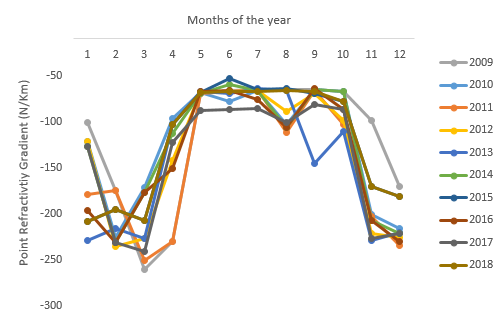Investigation of Point Refractivity Gradient and Geoclimatic Factor at 70 m Altitude in Yenagoa, Nigeria
Keywords:
GSM, WAN, Inter-Terrestrial, Microwave, Geoclimatic Factor, Refractivity GradientAbstract
The quality of services provided via Inter-Terrestrial radio communication links such as GSM networks, Wide Area Network (WAN), Radio and TV broadcasts is largely influenced by some meteorological parameters such as temperature, pressure and humidity. Proper knowledge of these parameters, specifically at microwave antenna heights (about 70m) is important in order to maintain an effective line-of-sight (LOS) link even during the worst weather conditions. The geoclimatic factor is an important quantity that must be considered in the design of terrestrial links for effective wireless communication. This work utilized satellite data from the European Center for Medium-Range Weather Forecasts (ECMWF) to compute the point refractivity gradient and geoclimatic factor for Yenagoa and its environs. The research was necessitated by the paucity of research on this subject matter for Yenegoa. The results of the research show that point refractivity gradient and geoclimatic factor in the study area vary with season. The average point refractivity gradient and geoclimatic factor at 70 m above the ground level are:136.433 N-unit/Km and 6.638633E-05 respectively. This implies that radiowaves propagating in this region at the said altitude is most likely to be super refractive in both rain and clear air atmospheric conditions. Rain or worst condition refers to the period when atmospheric components such as hydrometeor, lithometeor, aerosol have significant effects on propagated radio signals. Clear-air conditions means when maximum possible signal is received such that the most threatening atmospheric components (rain drops) have negligible effects on propagated signal. The results will be useful for radio engineers in the design and configuration of inter-terrestrial microwave links in Yenagoa and Its environs for optimum quality of service.

Published
How to Cite
Issue
Section
Copyright (c) 2023 Y. B. Lawal, E. T. Omotoso

This work is licensed under a Creative Commons Attribution 4.0 International License.




